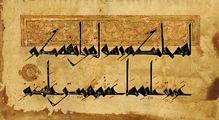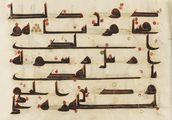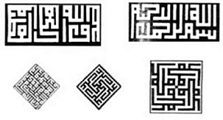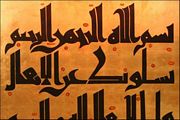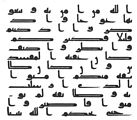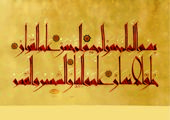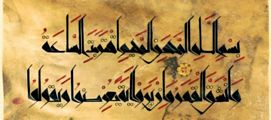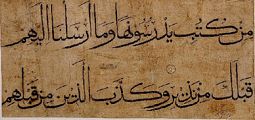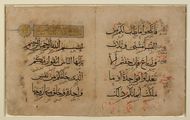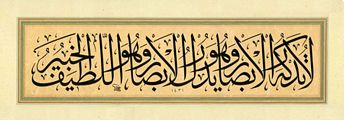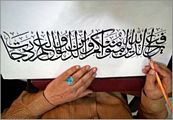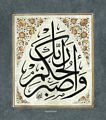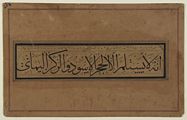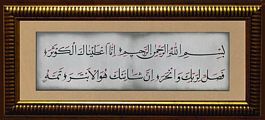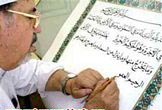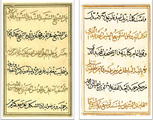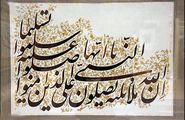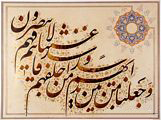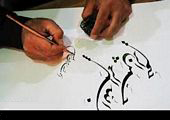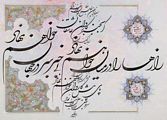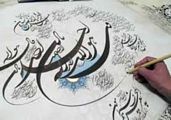
About Arabic Calligraphy
The art of Arabic calligraphy started in the first century after initiation of Islam and "Kufic" was the very first style of Arabic calligraphy and the first Korans have been written in this style of Arabic calligraphy.
Kufic; The Oldest Arabic Calligraphy Style:
In the coming centuries several forms of Kufic script emerged as the early Arabic calligraphy artists talents flourished. It is believed that "Ebn-e Muqla' Beyzavi Shirazi" has been the first Arabic calligraphy master who classifies the different scripts of Arabic calligraphy and outlines a solid structure of rules and principles for each and every one of the styles of Arabic calligraphy. He classifies these calligraphic styles as "Aqlaam-e Setta" or "six Scripts" as follows:
1 - Muhaqqaq
2 - Rayhani
3 -Thuluth
Re 4 - Naskh
5 -Towqi'
6 - Reqaa' (Riqaa')
1 - Muhaqqaq
"Muhaqqaq" means fulfilled, complete, and correct; and this is the first style that is driven from the original Kufic and given an independent identity. "Muhaqqah" has long pen stokes and sharp pen-drops.
Principles of this calligraphy style is based on 4.5 sixth or "flatness" vs "1.5 sixth of "curve".
2 - Rayhani
Some of the Arabic calligraphy masters believe "Rayhani" belongs to "Naskh" family and some other believe it is a close relative of "Thuluth"; some others consider Rayhani is Muhaqqaq's sister script as it has all the same principles but the body of the words become slimmer and a little shorter. "Rayhan" means "basil" or in general it means "herbs" and perhaps the delicate form of letters and connections made the masters to name this script this way as it resembles the freshness and smoothness of basil.
"Yaqout Mosta'sami" is one of the most famous calligraphers in the course of history of Rayhan script:
3 -Thuluth
Thuluth is the most popular style in modern Arabic calligraphy and the strong tall vertical strokes combined with smooth rhyming curves provide this style with a very unique identity. As mentioned this style is very popular especially among the calligraphers in Iraq, Iran, Syria, Egypt, Pakistan and Turkey.
4 - Naskh
This style of Arabic calligraphy is the most popular Koranic script as it is easy to read.... simple, yet elegant. One of the most important aspects of this script is the proportions, balance and harmony between the letters and connections and combinations.
5 -Towqi'
This style of Arabic calligraphy is the most popular to write the official letters or government declarations or messages.
Principles of this calligraphy style is based on 2 sixth or "flatness" vs "3 sixth of "curve".
6 - Reqaa' (Riqaa')
This calligraphic style has been designed for letter writing as is is a faster and briefer version of Twoqi' that later became an independent style. The word "Reqaa'" means little letters (less formal).
Persian Calligraphy
Throughout the past several centuries, there have been three distinct calligraphic styles that Persians use: Taliq, Nastaliq, and Cursive Nastaliq (AKA Shekasteh Nastaliq). Here are samples of each of these calligraphy styles:
1 - Taliq (Ta'liq, Ta'leeq)
2 - Nastaliq (Nasta'liq, Nastaleeq, Nastaligh, Nastaleegh)
3 - Cursive Nastaliq (Shekasteh Nasta'liq, Shikasta Nastaliq)
More and more informative material will be posted here in this section of the website in the coming weeks. Please make sure to check our website periodically for more information or to suggest material to post here please contact us.




